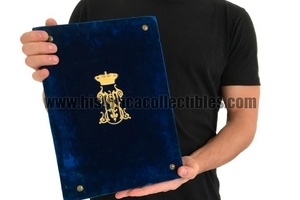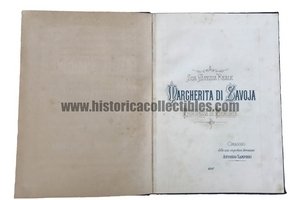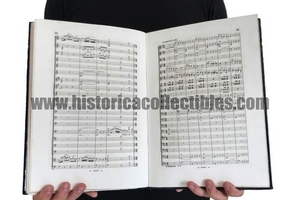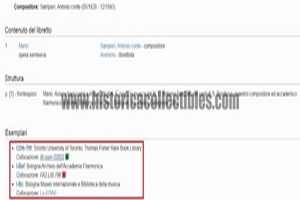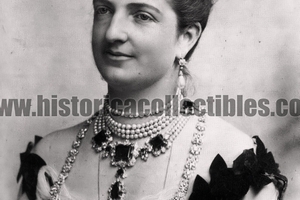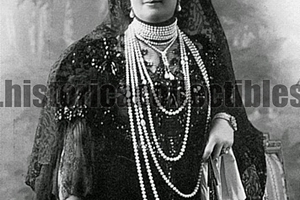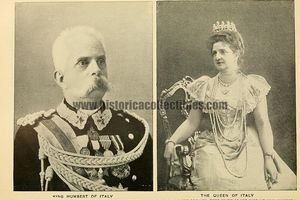Composition Stabat Mater, Queen Margherita of Savoy (Gift of Antonio Sampieri), circa 1860
Composition of the "Stabat Mater" which belonged to Queen Margherita of Savoy (then Princess of Piedmont and future wife of King Umberto I) given to her by the important and well-known Bolognese composer Antonio Sampieri of the Counts of Bonifacio.
This composition belonged personally to Queen Margherita and collected in an important blue velvet binding with the Royal monogram relating to Queen Margherita, was personally offered by the composer to the Queen in around 1860 and is cited in an important volume entitled "The Italian Music Masters of Secolo XIX" by Professor Giovanni Masutto published in Venice in 1884 by the "Premiato Stabilimento Tipografico di Giovanni Cecchini" where all the important works that were commissioned to Sampieri by the powerful of Europe are collected:
The Lessons of Job, written for H. M. Louis I of Portugal;
Solemn mass for His Majesty the Emperor of Austria;
Triumphal march for H. M. Don Amedeo I, King of Spain;
Furthermore, H. M. Amedeo I, King of Spain, awarded him the Spanish Chivalric Order of Carlo Terziero with its diploma and H. M. Louis I, King of Portugal, wanted to create him a Knight of the Portuguese Military Order of the Conception with a diploma bearing his signature.
5 of his works are preserved in the "International Museum and Library of Music of Bologna", at the "University of Toronto" in Toronto and at the Archives of the "Accademia Filarmonica" in Bologna.
Sampieri is also cited:
In the book, published in 2003 by Andrea Sessa, "Il melodramma italiano 1861-1900" which is a Bio-Bibliographical Dictionary of 19th century Composers".
In Stieger Franz's book "Opernlexikon" published in 1944 by Hans Schneider.
In Volume II of the "Universal Dictionary of Musicians" by Carlo Schmidl published in Milan by Sonzogno in 1937.
In Karl Lustner's book "Totenliste des Jahres 1893 die Musik betreffend" (page 137) published by Monatshefte fur Musikgeschichte in 1894.
In the third edition of Masutto Giovanni's collection "The Italian Music Masters of the 19th Century published in Venice in 1882.
Finally cited on page 226 of the volume "The Italian Music Masters of Our Century" by Giovanni Masutto published in Venice, by the Stab. typ. lit. M. Fontana, in 1880.
Furthermore, within the work, there are some scores handwritten and autographed by Sampieri in addition to the work published in the bound composition.
SAMPIERI ANTONIO (Born in Bologna in 1828 and died in 1893 in Bologna).
From the volume published in 1886: Composer, he was born in Bologna in May 1828. At about 6 years old he began to study the piano with maestro Antonio Sarti, organist, chapel master of the Basilica of San Petronio and librarian at the musical high school of Bologna, and more late the violin first with the prof. Gaetano Covoni from Bologna, good violinist, then in Modena for 7 years in the Collegio dei Nobili, now S. Carlo, with Sighicelli, court player of great fame and director of the Municipal Theatre.
His first composition teacher was the illustrious Cavaliere Giuseppe Busi, professor-teacher at the Bologna Music High School, father of the young Alessandro who today so worthily occupies the place of his deceased parent, very learned in the science of counterpoint, fugues and severe compositions. After obtaining his law degree, Sampieri resumed his musical studies under the guidance of Francesco Roncagli, now organist at the Petroniana Basilica.
After a short time he went to Rome to the famous Raimondi to practice composing Antiphon and Canons.
In 1851 he moved to Florence to perfect himself in orchestration with the guidance of Maestro Pacini, and in Florence and Viareggio Count Sampieri began and finished his Oratorio: Ruth and Noemi.
He then returned to Bologna and gave an experiment at the Philharmonic Academy, obtaining from it in 1868 the diploma of master composer and honorary member and on 24 November of the same year, the Academy-Congregation of S. Cecilia in Rome also awarded him the diploma of first class master composer.
The Royal Musical Institute of Florence, the Philharmonic Dramatic Academy of Ferrara, the Regia Accademia Raffaello of Urbino, the Institute of Fine Arts of the Marche, other Academies and Associations of Naples and Palermo still count him among their honorary members.
Antonio Sampieri of the counts of S. Bonifacio, says one of his biographers, is one of the most persevering, the most generous, the most distinguished lovers of the musical art that Bologna boasts. In Sampieri's works the melodic ideas are all beautiful, they have a serious character, they vividly portray the feeling of the poetry with which they are accompanied and are carried out and conducted with true and frank originality.
There are many musical works by Count Sampieri, including:
The Lessons of Job, written for H. M. Louis I of Portugal;
Solemn mass for His Majesty the Emperor of Austria;
Triumphal march for H. M. Don Amedeo I King of Spain;
the Stabat Mater written, dedicated and personally offered to Queen Margherita, then Princess of Piedmont.
The compositions are all very lively, where a classic style and exquisite taste are combined with clear and harmonious melodies.
QUEEN MARGHERITA: Margherita Maria Teresa Giovanna of Savoy (Turin, 20 November 1851 – Bordighera, 4 January 1926), Queen consort of King Umberto I, was the first queen consort of Italy as the wife of King Vittorio Emanuele II, Maria Adelaide of Austria had died in 1855, before the proclamation of the Kingdom in 1861. In the years in which she was at Umberto's side as Crown Princess and, from 1878, as Queen of Italy, she exercised considerable influence on her husband's choices and a great charm on the population, making wise use of his public appearances, designed to attract the people with refined clothing and constant affability.
According to Ugoberto Alfassio Grimaldi, she was the political figure of united Italy who aroused, after Giuseppe Garibaldi and Benito Mussolini, «the greatest enthusiasm in the upper classes and the humble classes».
She was Catholic, fiercely attached to the House of Savoy and profoundly reactionary, she was a convinced nationalist and supported the imperialist policy of Francesco Crispi. The incitement to repress popular revolts, as happened in the Milan riots of 1898, although controversial, did not compromise her image, perhaps because she was the first Italian woman to sit on the throne of the newly established country.
At court she ran a weekly cultural club which earned her the admiration of poets and intellectuals and placed her perhaps, at least in this respect, more to the left than many other ladies of the aristocracy.
Furthermore, her balls, like those in which she participated, often concealed a diplomatic plan, and in her intentions they sought in particular to ensure mediation with the "black" aristocracy, which remained faithful to the Vatican after the capture of Rome.
There were many popular and poetic tributes paid to the noblewoman (from the pizza Margherita to Carducci's famous ode to the Queen of Italy, written immediately after the sovereign's visit to Bologna in November 1878), even in the years following her husband's assassination, when she became queen mother.

